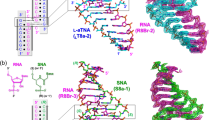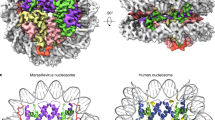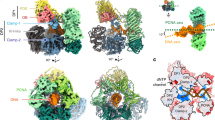Abstract
THE synthetic polymers, polyadenylic acid (A) and polyuridylic acid (U) interact strongly when mixed together in aqueous solution. Evidence for interaction on mixing comes from many observations, including increases in viscosity, sedimentation coefficient and molecular weight and decrease in ultraviolet absorption1. The last phenomenon, referred to as a hypochromic effect, is observed in the reverse fashion for deoxyribonucleic acid (P. Doty, private communication), that is, on thermal disruption of the double chain helical molecule in solution there is a substantial increase (about 30 per cent) in the optical density. This parallel behaviour of deoxyribonucleic acid and the chemically related synthetic complex suggests that their structures may be comparable. Added weight to this view is given by X-ray diffraction pictures2 which show remarkable similarities between naturally occurring deoxyribonucleic acid and a synthetic fibre of polyadenylic acid/polyuridylic acid (AU) drawn from a solution containing equimolar portions of polyadenylic and polyuridylic acids. These facts have led Rich3 to propose that the hydrogen bonding in the polyadenylic acid/polyuridylic acid complex is of the same type as that observed between adenine and thymine in deoxyribonucleic acid.
This is a preview of subscription content, access via your institution
Access options
Subscribe to this journal
Receive 51 print issues and online access
$199.00 per year
only $3.90 per issue
Buy this article
- Purchase on Springer Link
- Instant access to full article PDF
Prices may be subject to local taxes which are calculated during checkout
Similar content being viewed by others
References
Warner, R. C., Fed. Proc., 15, 379 (1956).
Rich, A., Special Publications of the New York Academy of Sciences, 5, 86 (Published by the Academy, 1957).
Felsenfeld, G., Davies, D. R., and Rich, A., J. Amer. Chem. Soc., 79, 2023 (1957). Felsenfeld, G., and Rich, A., Biochim. Biophys. Acta, 26, 457 (1957).
Rich, A., Nature, 181, 521 (1958).
Zubay, G., and Doty, P., Biochim. Biophys. Acta (in the press).
Zubay, G., Biochim. Acta (in the press).
Cochran, W., Acta Cryst., 4, 81 (1951).
Langridge, R., Seeds, W. E., Wilson, H. R., Hooper, C. W., Wilkins, M. H. F., and Hamilton, L. D., J. Biophys. Biochem. Cyt., 3, 767 (1957).
Zubay, G., Nature, [182, 112 (1958)].
Author information
Authors and Affiliations
Rights and permissions
About this article
Cite this article
ZUBAY, G. A Three-stranded Polyribonucleotide Structure. Nature 182, 388–390 (1958). https://doi.org/10.1038/182388a0
Issue Date:
DOI: https://doi.org/10.1038/182388a0
This article is cited by
Comments
By submitting a comment you agree to abide by our Terms and Community Guidelines. If you find something abusive or that does not comply with our terms or guidelines please flag it as inappropriate.



